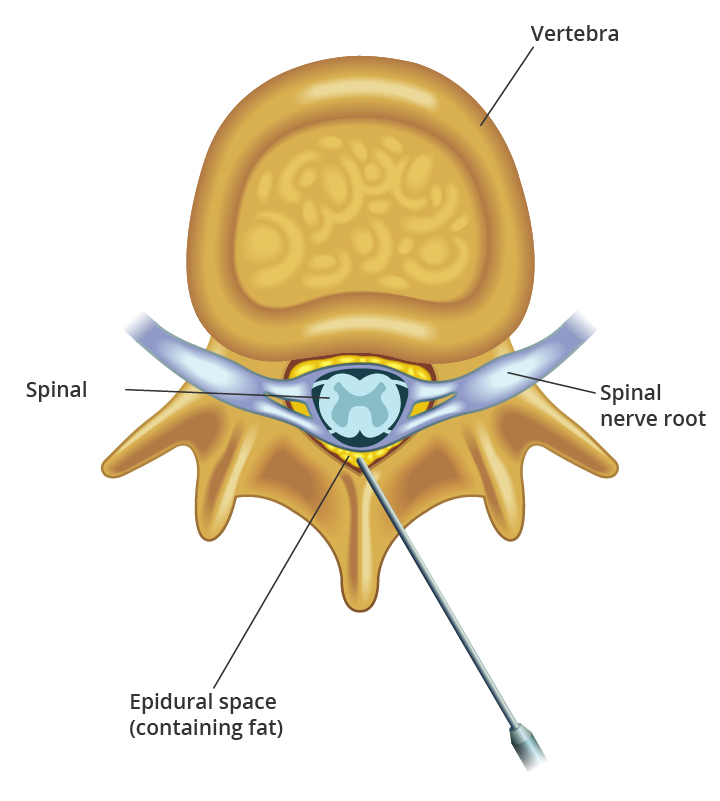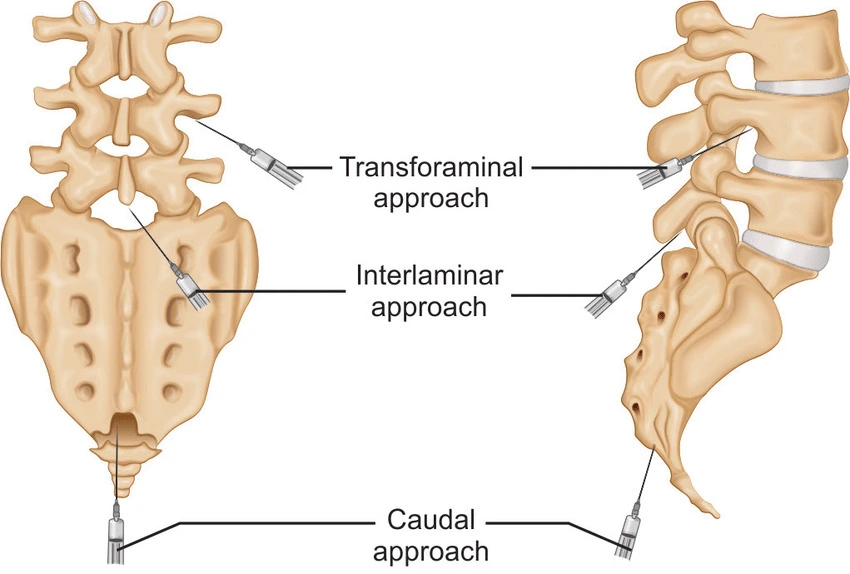Lumbar Epidural Steroid Injections
Lumbar Epidural Steroid Injections: Relief for Lower Back and Leg Pain
What Are Lumbar Epidural Steroid Injections?
A lumbar epidural steroid injection delivers anti-inflammatory medication directly into the epidural space. This space surrounds the spinal cord and nerve roots in the lower back. Inflammation in this area can cause significant pain, often radiating into the legs—a condition known as sciatica.
The injection contains a corticosteroid and a local anesthetic. The steroid reduces inflammation, while the anesthetic provides short-term pain relief. These injections treat pain caused by several conditions, including herniated discs, spinal stenosis, and degenerative disc disease.

How Epidural Steroid Injections Relieve Pain
Inflammation in the epidural space irritates nerve roots, leading to persistent pain. Steroids target this inflammation, reducing swelling and decreasing the pressure on affected nerves. This helps relieve pain, improve mobility, and prevent flare-ups.
ESIs are not a cure for underlying conditions. Instead, they manage symptoms, allowing patients to pursue additional treatments like physical therapy. For some, ESIs provide relief for several months or longer. Others may require repeat injections as part of their pain management plan.
Conditions Treated with Lumbar Epidural Steroid Injections
ESIs treat several common spinal conditions:
- Herniated discs: When a disc bulges or ruptures, it compresses nearby nerves. This compression can cause sharp pain in the lower back and legs.
- Spinal stenosis: Narrowing of the spinal canal can pinch nerves, leading to pain and numbness.
- Sciatica: Inflammation of the sciatic nerve causes pain that radiates down the leg.
- Degenerative disc disease: Over time, spinal discs lose moisture, reducing their ability to cushion vertebrae and leading to pain.
- Spondylolisthesis: A vertebra slips forward, irritating nerves and causing pain.
These injections are especially beneficial when conservative treatments, like medications and physical therapy, have failed.
Who Is a Good Candidate for Epidural Steroid Injections?
Patients with persistent lower back or leg pain may benefit from ESIs. They are ideal for individuals with:
- Pain that radiates from the lower back into the legs
- Numbness, tingling, or weakness in the legs
- Difficulty walking or standing for long periods
Patients should consult with their healthcare provider to determine if ESIs are appropriate. Those with infections, bleeding disorders, or certain medical conditions may need to avoid this treatment.
Types of Lumbar Epidural Steroid Injections
There are three common approaches for lumbar ESIs:
-
- Interlaminar injection: Medication is delivered into the epidural space from the back.
- Transforaminal injection: The needle is placed near the nerve root, providing targeted relief.
- Caudal injection: The injection enters the epidural space from the base of the spine.
Each approach offers unique advantages, and your doctor will choose the best option based on your condition.

What to Expect During the Procedure
The procedure is performed in an outpatient setting, such as a medical office under sterile conditions. The procedure usually takes less than 15 minutes. Here’s a step-by-step overview:
- Preparation: The patient lies face down on a table. A local anesthetic numbs the injection site.
- Imaging guidance: Fluoroscopy, a type of live X-ray, helps guide the needle to the correct location.
- Injection: The physician delivers the steroid and anesthetic mixture into the epidural space.
- Observation: Patients are monitored for a short time to ensure there are no complications.
The injection itself causes little discomfort, thanks to the local anesthetic. Most patients return home the same day.
Recovery and Aftercare
Patients may experience some soreness at the injection site for a day or two. Applying ice packs can help relieve this discomfort. It’s important to avoid strenuous activities for 24 hours after the procedure.
Relief may not occur immediately. The steroid takes time to reduce inflammation, so improvement typically begins within a few days to a week. Some patients experience significant relief for several months. Others may need additional injections, spaced apart, to maintain pain relief.
Risks and Side Effects
Lumbar epidural steroid injections are generally safe, but some risks exist. Common side effects include:
- Temporary increase in pain at the injection site
- Headache due to a dural puncture
- Mild fever or nausea
Rare complications include infection, nerve damage, and bleeding. Patients should report any severe side effects to their physician immediately.
How Effective Are Epidural Steroid Injections?
Studies show that lumbar ESIs provide significant relief for many patients with lower back and leg pain. However, the duration of relief varies. Some patients enjoy pain relief for months, while others require a series of injections.
For best results, ESIs should be part of a broader treatment plan. Combining them with physical therapy, exercise, and lifestyle changes ensures long-term success.
Lumbar Epidural Steroid Injections vs. Other Treatments
While ESIs offer quick relief, other treatments may also play a role in managing pain.
- Medications: Anti-inflammatory drugs and muscle relaxers can reduce symptoms.
- Physical therapy: Strengthening core muscles helps stabilize the spine and reduce pain.
- Surgery: In severe cases, surgery may be necessary to address structural issues.
ESIs provide an effective middle ground, often preventing the need for more invasive procedures.
How long does the pain relief last?
Relief varies, lasting from weeks to several months, depending on the patient’s condition.
Are there limits to how many injections I can receive?
Most physicians recommend no more than three to four injections in a 12-month period.
Will the injection hurt?
Patients feel minimal discomfort due to the local anesthetic used during the procedure.
Can I drive home after the injection?
Patients should arrange for someone to drive them home, as the anesthetic may cause weakness of the legs.
In Summary
Lumbar epidural steroid injections offer meaningful relief for people suffering from lower back and leg pain. They reduce inflammation, alleviate nerve irritation, and improve mobility. While not a cure, ESIs can play an essential role in comprehensive pain management.
If you are struggling with sciatica, a herniated disc, or spinal stenosis, consider consulting with Red Butte Pain Solutions. Our experienced providers in Chandler, Arizona, will work with you to develop a personalized pain management plan. With the right treatment, you can regain your quality of life and live pain-free again.
Call us today at 602-633-4334 or Pre-Register to schedule your consultation and take the first step toward lasting relief.
What Causes Aching Pain Between the Shoulder Blades?
Aching pain between the shoulder blades is a common complaint that often comes and goes. But sometimes, it can be a sign of something more serious. Understanding the potential causes can help you get the right treatment. Common Causes of Aching Pain Between the...
Deep Dive: Transforaminal Epidural Steroid Injection
One of the most frequent injections I perform is a transforaminal epidural steroid injection. I'm often asked by patients, particularly women, "Is this like an epidural when you have a baby?" And I get to explain that it's really something altogether different. If...
Epidural Steroid Injections: Isn’t This Just a Band-Aid?
Epidural steroid injections are one of the most common procedures I perform. This is in no small part due to the fact that every year one of the top reasons people see a doctor is back pain. Patients often have questions like, “How does the steroid work to stop the...
Adjacent Segment Disease: A Patient’s Journey
The Sciatica Strikes Back A few weeks ago, a patient came to Red Butte Pain Solutions with severe lower back and leg pain. Years earlier, he had undergone surgery for a herniated disc. After the surgery, he felt better and lived pain-free. But now, the pain had...
From Pain to Relief: Treating Lumbar Disc Herniation in Arizona
At Red Butte Pain Solutions, we see patients with various types of back pain. One common condition we treat is lumbar disc herniation, including disc extrusions. A disc extrusion occurs when the soft inner material of a disc in the spine pushes through a tear in the...
Spinal Stenosis: Pathways to Relief
Spinal stenosis is a common condition that affects many people, especially as they age. If you're experiencing back pain and are unsure of the cause, it might be due to spinal stenosis. At Red Butte Pain Solutions in Chandler, Arizona, we specialize in diagnosing and...
